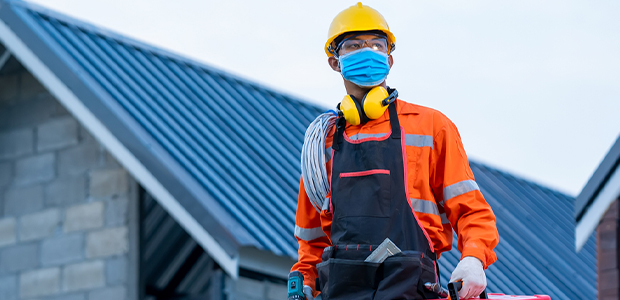
Construction Site and Facility Safety Through the Eyes of an Electrician
Safety is a choice that is made every day by each person; it is imperative that each of us on the job makes the right choice.
- By Dean Austin
- Sep 01, 2021
When does safety on a construction site or in a facility start? For electrical and other construction workers and employees, the answer is quite simple—the minute you walk into the facility or on to the construction site.
During renovations of facilities, and on most construction sites, there are locations that are damp, dirty and muddy filled with many hazards, seen and unseen, including uneven or soft ground, ladders, scaffolding and all types of equipment. As such, many facility and construction site safety managers or project managers require all individuals to don high visibility safety clothing or vests, hard hats, safety shoes and safety glasses just to enter the site or facility.
Most, if not all, construction sites and facilities require workers to have daily or weekly meetings to discuss job site safety. When there is a potential for exposure to any hazard, a good tool to use is the “Hierarchy of Risk Control Method” which, when used properly, can help reduce or eliminate risk to employees. The Hierarchy of Risk Control Method is:
*Elimination. Physically remove the hazard
*Substitution. Replace the hazard
*Engineering Controls. Isolate people from the hazard
*Awareness. Signs alerting of potential presence of hazards
*Administrative Controls. Change the way people work by having procedures and job planning tools
*PPE. Protect the worker with the correct gear
According to Electrical Safety Foundation International (ESFi), the Bureau of Labor Statistics recorded 1,900 nonfatal electrical injuries in 2019 involving days away from work. Of the 1,900 injuries, 27 percent involved construction site incidents.
With the Hierarchy of Risk Control Method, PPE is the last line of protection from any hazard. Electricians installing temporary and permanent electrical systems may face hazards other than electrical when working with or from ladders, lifts and scaffolding. Because not every hazard can be eliminated, a reduction in the risk to the hazard is the best solution. When a worker is operating a lift or scaffolding, or near any area that may subject them to a fall of six feet or more, that person must be using proper risk reduction methods such as fall protection. OSHA standards 1926 and 1910 address this topic. Other hazards electricians may encounter on a construction site include:
*Installation of raceways in trenches, which would require the worker to take proper precautions to protect against a collapse of the trench
*Cracked and frayed extension cords, broken plug ends and missing ground prongs
*Extension cords used as ropes for raising and lowering tools
*Extension cords being used without the required ground fault circuit interrupter (GFCI) protection, inside or outdoors
*Damaged temporary wiring or a lack of a connection of temporary wiring to a GFCI receptacle or device
*Ladders versus a lift or taller scaffolding to reach high areas
*A lack of fall protection when operating a “bucket” truck or “boom” lift, for example, to set parking lot poles
All construction sites and facilities come with hazards, including electrical, that require precautions to be taken to help eliminate or reduce the severity of injuries or even the possibility of death. That is why temporary wiring on a construction site or in a facility being remodeled (NFPA 70 Article 590) needs to be installed properly by qualified individuals, GFCI protected and free from potential physical damage. Depending on the state or local jurisdiction, a permit and inspection may also be required.
As a construction project moves further along towards a fully functioning facility, the site changes as do some of the hazards. Temporary wiring is removed, clean-up occurs and workers transition to using permanent power. To help reduce electrical hazards during this phase, GFCI protection must still be used for power tools and signage must be placed in view and labeled correctly, such as the available fault current labels or the electric shock/arc flash warning labels. Although not required, it is also beneficial to have updated electrical drawings revised as “as-built drawings” and checked to verify that the one-line diagram is accurate.
Having accurate as-built-drawings and one-line diagrams will help determine where electrical energy originates so electrical hazards can be properly identified and temporarily eliminated by establishing an electrically safe work condition. This may not seem important to the installer but is a valuable part of a safety program for the facility safety manager and maintenance employees. Also, if elimination of electrical hazards is not an option, having the code required available will help calculate the potential arc-flash hazard and determine additional methods needed for the protection of employees.
Construction site and facility safety focuses on conducting and documenting a risk assessment of some kind. Typically, this is done by the construction site or facility safety officer or safety manager. They will look over the site, assess it, document the hazards then ensure these hazards are addressed. But ultimately, it is the worker who needs to follow the risk assessment procedure to assess and document hazards for each of his/her own tasks and take the proper precautionary or mitigation measures. Not following safety procedures can have dire consequences for the individual, his/her family, employer and colleagues. Safety is a choice that is made every day by each person; it is imperative that each of us on the job makes the right choice.
This article originally appeared in the September 2021 issue of Occupational Health & Safety.